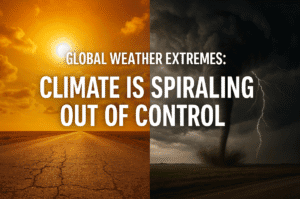Global Weather Extremes: 5 Shocking Signs Our Climate Is Spiraling Out of Control
Unseasonal heatwaves and severe storms are gripping the Northern Hemisphere, underscoring escalating climate volatility. Eastern U.S. cities like Washington, D.C., will swelter near 30°C (86°F)—6–8°C above April averages—as high-pressure systems lock in summer-like warmth prematurely. Western Europe braces for 25–28°C (77–82°F) temperatures, raising drought concerns amid uncharacteristic dry spells.
Meanwhile, Pakistan’s Sindh province faces life-threatening 49°C (120°F) heat, straining infrastructure and vulnerable populations, though monsoon-driven storms in early May may bring chaotic relief via floods and dust storms. In the U.S. Midwest, clashing air masses threaten tornado outbreaks, hail, and damaging winds, highlighting the growing risks of intensified spring storms.
These extremes align with broader climate trends: rising global temperatures amplify heatwaves, while warmer air fuels heavier rainfall and storm ferocity. Authorities urge proactive safety measures—from heat advisories to emergency storm plans—as communities grapple with the tangible impacts of a destabilizing climate.

Global Weather Extremes: 5 Shocking Signs Our Climate Is Spiraling Out of Control
As spring transitions toward summer, regions across the Northern Hemisphere are grappling with unseasonal weather extremes—from record-breaking heat to life-threatening storms. Here’s a breakdown of what’s unfolding and why these patterns matter.
US Eastern States: Summer Heat Arrives Early
Washington, D.C., and parts of the eastern U.S. are bracing for temperatures nearing 30°C (86°F) this week—a stark departure from April’s average highs of 20°C (68°F). This 6–8°C spike is fueled by a high-pressure system trapping warm air over the region. While sunny skies may entice residents outdoors, health experts advise caution: early-season heat can catch people unprepared, increasing risks of heat exhaustion. Vulnerable groups, like the elderly, are urged to stay hydrated and avoid midday sun.
Western Europe’s Taste of Summer
Cities from London to Berlin are set to experience their warmest days of 2025 so far, with temperatures soaring to 25–28°C (77–82°F). A persistent high-pressure zone over the continent is driving this dry, sunny spell—ideal for outdoor activities but raising concerns about drought conditions. In the UK, where April showers are typical, farmers are eyeing the dry spell warily, as prolonged heat could stress crops like barley and wheat.
South Asia’s Relentless Heatwave
Pakistan’s Sindh province faces thermometers hitting 48–49°C (118–120°F), surpassing April averages by 7°C. Such extreme heat, particularly in urban areas like Karachi, strains power grids and poses lethal risks for outdoor laborers. Authorities have declared health alerts, advising against daytime work and prioritizing access to cooling centers.
A Glimmer of Relief: By early May, moisture from the Arabian Sea is expected to trigger thunderstorms, offering respite from the heat. However, this shift brings its own dangers—dust storms, hail, and flash floods could disrupt travel and damage crops.
US Midwest Braces for Tornado Outbreak
While the east basks in heat, the Midwest faces a severe storm surge. Clashing air masses—warm, humid Gulf air colliding with cooler northern fronts—are creating perfect conditions for tornadoes and hail. States like Iowa and Illinois could see damaging winds exceeding 70 mph, with flooding risks in low-lying areas.
Safety First: Meteorologists emphasize having emergency plans in place. Residents in tornado-prone areas should identify sturdy shelters and monitor weather alerts. The storm system will track northeastward, potentially affecting cities like Chicago and Detroit before weakening midweek.
Why This Matters Beyond the Forecast
These simultaneous extremes highlight the growing volatility of global weather patterns. While individual events can’t be directly attributed to climate change, rising global temperatures are intensifying heatwaves and altering storm dynamics. For instance, warmer air holds more moisture, fueling heavier rains and stronger storms.
Staying Ahead of the Weather
- Heat Safety: Wear light clothing, hydrate frequently, and check on vulnerable neighbors.
- Storm Preparedness: Secure outdoor items, charge devices, and heed evacuation advisories.
- Stay Informed: Use trusted weather apps for real-time updates.
As these events unfold, they underscore the importance of adaptive infrastructure and community resilience. Whether it’s retrofitting cities to handle heat or reinforcing flood defenses, proactive measures are critical in an era of climatic unpredictability.
From scorching pavements to swirling skies, this week’s weather serves as a reminder: nature’s rhythms are shifting, and preparedness is no longer optional—it’s essential.
You must be logged in to post a comment.